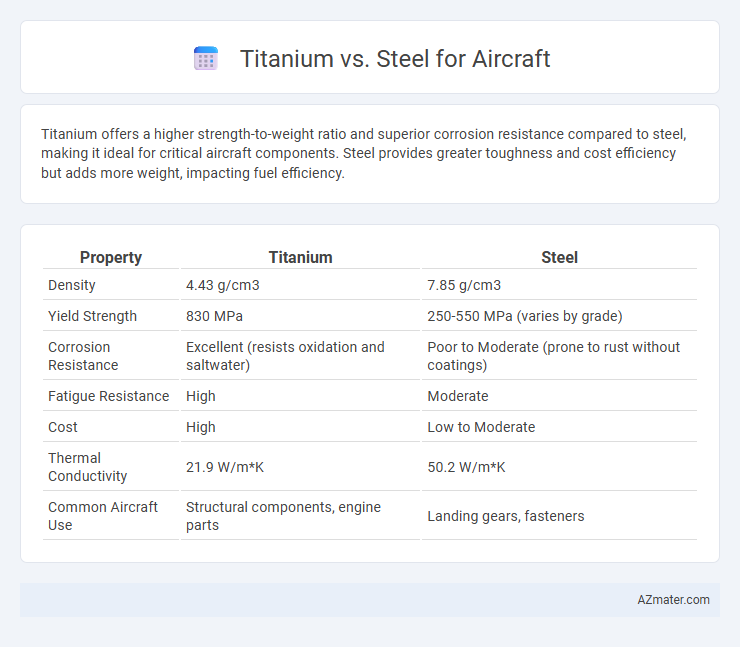Titanium offers a higher strength-to-weight ratio and superior corrosion resistance compared to steel, making it ideal for critical aircraft components. Steel provides greater toughness and cost efficiency but adds more weight, impacting fuel efficiency.
Table of Comparison
| Property | Titanium | Steel |
|---|---|---|
| Density | 4.43 g/cm3 | 7.85 g/cm3 |
| Yield Strength | 830 MPa | 250-550 MPa (varies by grade) |
| Corrosion Resistance | Excellent (resists oxidation and saltwater) | Poor to Moderate (prone to rust without coatings) |
| Fatigue Resistance | High | Moderate |
| Cost | High | Low to Moderate |
| Thermal Conductivity | 21.9 W/m*K | 50.2 W/m*K |
| Common Aircraft Use | Structural components, engine parts | Landing gears, fasteners |
Introduction to Titanium and Steel in Aircraft Manufacturing
Titanium and steel are critical materials in aircraft manufacturing due to their unique properties and performance capabilities. Titanium offers high strength-to-weight ratio, excellent corrosion resistance, and can withstand extreme temperatures, making it ideal for airframe components and engine parts. Steel provides superior toughness and fatigue resistance, often used in landing gear and fasteners where strength and durability are paramount.
Material Properties: Titanium vs Steel
Titanium offers a superior strength-to-weight ratio compared to steel, making it ideal for aircraft components where weight reduction is critical. Its excellent corrosion resistance and high fatigue strength enhance durability under extreme aerospace conditions. Steel, while stronger in yield strength, tends to be heavier and more susceptible to corrosion, limiting its application in weight-sensitive aircraft structures.
Weight Comparison: Impact on Aircraft Performance
Titanium offers a significant weight advantage over steel, with a density of approximately 4.5 g/cm3 compared to steel's 7.8 g/cm3, resulting in nearly 40% weight reduction when used in aircraft structures. This lower weight enhances fuel efficiency, increases payload capacity, and improves overall aircraft performance by reducing takeoff weight and increasing range. The strength-to-weight ratio of titanium is superior, allowing for thinner, lighter components without compromising structural integrity.
Strength and Durability: Assessing Structural Integrity
Titanium offers exceptional strength-to-weight ratio, providing superior structural integrity compared to steel in aircraft applications. Its high resistance to corrosion and fatigue contributes to enhanced durability, ensuring prolonged service life under extreme stress conditions. Steel, while stronger in absolute tensile strength, is heavier and more prone to corrosion, making titanium the preferred choice for critical aircraft components requiring optimal strength and longevity.
Corrosion Resistance in Aviation Environments
Titanium exhibits superior corrosion resistance compared to steel in aviation environments due to its stable oxide layer that prevents oxidation and metal degradation. Steel, particularly carbon steel, is more susceptible to rust and corrosion from exposure to moisture, salt, and chemicals commonly encountered during flight operations. Aerospace-grade stainless steel improves corrosion resistance but still cannot match titanium's lightweight, high-strength properties combined with exceptional durability against environmental stresses.
Cost Analysis: Titanium vs Steel
Titanium exhibits a higher initial material cost than steel, often costing three to four times more per pound, but offers superior strength-to-weight ratio and corrosion resistance that can reduce long-term maintenance and fuel expenses. Steel remains more affordable upfront, with widespread availability and easier fabrication, yet its heavier weight contributes to increased fuel consumption and potential maintenance costs over the aircraft's lifecycle. When analyzing cost efficiency, titanium's premium price can be offset by improved performance, longevity, and lower lifecycle expenditures, making it a strategic choice for high-performance and fuel-efficient aircraft designs.
Manufacturing and Machinability Differences
Titanium offers superior corrosion resistance and a higher strength-to-weight ratio compared to steel, making it ideal for aircraft components that require less weight and enhanced durability. Manufacturing titanium is challenging due to its reactivity at high temperatures, requiring specialized equipment and processes such as vacuum melting and inert gas shielding to prevent contamination. Steel, while heavier, is easier to machine and weld using conventional methods, allowing for faster production cycles and lower manufacturing costs in aircraft structures.
Applications in Aircraft: Where Each Material Excels
Titanium excels in aircraft applications requiring high strength-to-weight ratio, corrosion resistance, and the ability to withstand extreme temperatures, making it ideal for engine components, airframes, and landing gear. Steel is preferred for structural parts requiring high toughness and fatigue resistance, such as in fasteners, engine shafts, and landing gear components that endure heavy loads and impact. The combination of titanium's lightweight properties with steel's durability optimizes aircraft performance and safety in different critical areas.
Environmental and Lifecycle Considerations
Titanium's superior corrosion resistance and higher strength-to-weight ratio contribute to lower maintenance requirements and extended aircraft lifespan compared to steel, reducing overall environmental impact. The energy-intensive extraction and processing of titanium are offset by fuel savings during the operational phase due to lighter aircraft weight. Steel, while more recyclable and less costly to produce, typically results in heavier airframes that increase fuel consumption and greenhouse gas emissions throughout the aircraft's lifecycle.
Future Trends: Evolving Roles of Titanium and Steel in Aviation
Titanium's superior strength-to-weight ratio and corrosion resistance drive its expanding use in aerospace components, enhancing fuel efficiency and durability. Advanced steel alloys are evolving to offer higher strength and cost-effectiveness, maintaining their role in structural parts and landing gear. Emerging manufacturing techniques like additive manufacturing and hybrid material composites are shaping the future integration of titanium and steel in aircraft design.

Infographic: Titanium vs Steel for Aircraft
 azmater.com
azmater.com